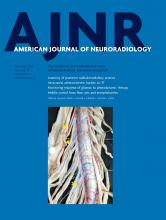Table of Contents
Perspectives
Review Articles
Clinical Vignette
General Contents
- Anatomy of the Great Posterior Radiculomedullary Artery
The authors describe the microsurgical anatomy of the great posterior radiculomedullary artery with emphasis on its morphometric parameters as well as its implications for spinal cord blood supply. The artery of Adamkiewicz in spinal cord specimens (n = 50) was injected with colored latex until the small-caliber arterial vessels were filled and the great posterior radiculomedullary artery was identified. The course, diameter, and location of great posterior radiculomedullary artery were documented. A great posterior radiculomedullary artery was identified in 36 (72%) spinal cord specimens. In 11 (22%) specimens, bilateral great posterior radiculomedullary arteries were present. In 13 cases (26%), a unilateral left-sided great posterior radiculomedullary artery was identified. In 11 cases (22%), a unilateral right-sided great posterior radiculomedullary artery was identified.
- Intracranial Atherosclerotic Burden on 7T MRI Is Associated with Markers of Extracranial Atherosclerosis: The SMART-MR Study
Intracranial atherosclerosis, a major risk factor for ischemic stroke, is thought to have different atherogenic mechanisms than extracranial atherosclerosis. Studies investigating their relationship in vivo are sparse and report inconsistent results. Within the Second Manifestations of ARTerial disease–Magnetic Resonance (SMART) Study, cross-sectional analyses were performed in 130 patients with a history of vascular disease and with assessable 7T intracranial vessel wall MR imaging data. Intracranial atherosclerosis burden was defined as the number of intracranial vessel wall lesions in the circle of Willis and its major branches. Significant associations were observed between higher intracranial atherosclerosis burden and carotid intima-media thickness, 50%–100% carotid stenosis versus no stenosis, ankle-brachial index, and estimated glomerular filtration rate. No significant differences in intracranial atherosclerosis burden were found among different categories of vascular disease.
- Prevalence of Asymptomatic Middle Cranial Fossa Floor Pits and Encephaloceles on MR Imaging
A retrospective review was completed of high-resolution axial T2WI for internal auditory canal protocol imaging. The presence and laterality of middle cranial fossa pits (small bony defects containing CSF) and encephaloceles (brain parenchyma protrusion through osseous defects with or without bony remodeling) were recorded. A total of 203 patients were included in the final cohort; 106 (52.2%) were women. Forty-five (22.2%) patients had middle cranial fossa pits: 14 (31.1%) unilateral on the right, 17 (37.8%) unilateral on the left, and 14 (31.1%) bilateral. Ten (5.0%) patients had one or more encephaloceles, none of whom had a documented history of seizure in the electronic medical record. The incidence of such findings should be taken into account when identifying or treating such lesions as possible epileptogenic foci.
- Identification of Vortex Cores in Cerebral Aneurysms on 4D Flow MRI
The authors subjected 40 aneurysms (37 unruptured, 3 ruptured) to 4D flow MR imaging. They visualized streamlines with velocities below the threshold—that is, a percentage value of the aneurysm maximum inflow velocity—and progressively decreased the threshold to identify vortex cores as thin, streamline bundles with minimum velocities. A simple flow pattern (single vortex core) was identified in 27 aneurysms; the other 13 exhibited a complex flow pattern. The cores were stable in 32 and unstable in 8 aneurysms. Significantly more aneurysms with-than-without blebs or daughter sacs had a complex flow pattern. The identification of vortex cores on 4D flow MR imaging may help to stratify the rupture risk of unruptured cerebral aneurysms.
- Ultra-High-Field Targeted Imaging of Focal Cortical Dysplasia: The Intracortical Black Line Sign in Type IIb
Between 2013 and 2019, the authors performed a standardized 7T MR imaging protocol in patients with drug-resistant focal epilepsy. They focused on 12 patients in whom postsurgical histopathology revealed focal cortical dysplasia and explored the diagnostic yield of preoperative 7T versus 1.5/3T MR imaging and the correlations of imaging findings with histopathology. They observed clear abnormalities in 10/12 patients using 7T versus 9/12 revealed by 1.5/3T MR imaging. In patients with focal cortical dysplasia I, 7T MR imaging did not disclose morphologic abnormalities (n= 0/2). In patients with focal cortical dysplasia II, 7T uncovered morphologic signs that were not visible on clinical imaging in 1 patient with focal cortical dysplasia IIa (n= 1/4) and in all those with focal cortical dysplasia IIb (n= 6/6). T2*WI provided the highest added value. The authors conclude that the high sensitivity of 7T T2*-weighted images provides an additional tool in defining potential morphologic markers of high epileptogenicity within the dysplastic tissue of focal cortical dysplasia IIb and will likely help to more precisely plan epilepsy surgery.
- Cerebellar Heterotopias: Expanding the Phenotype of Cerebellar Dysgenesis in CHARGE Syndrome
The authors performed a retrospective, observational, cross-sectional study to assess the prevalence and characteristic features of cerebellar heterotopias in 35 patients with CHARGE syndrome with available brain MR imaging studies, as well as to evaluate additional features of cerebellar dysgenesis. Cerebellar heterotopias were identified in 27/35 (77%) patients with CHARGE, characteristic in both location and appearance. Additional features of cerebellar dysgenesis were present in 31/34 evaluable patients (91%), including inferior vermian hypoplasia (90%), anteromedial rotation of the inferior tonsils (90%), and disorganized foliation of the cerebellar hemispheres (74%) or superior vermis (16%). Patients with CHARGE syndrome have a high prevalence of characteristic cerebellar heterotopias.
Online Features
Letters








